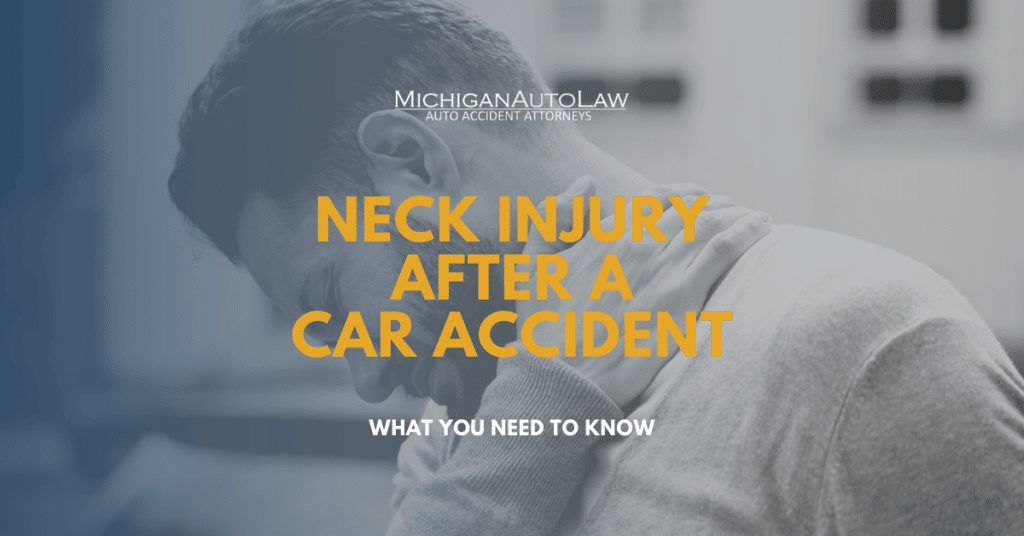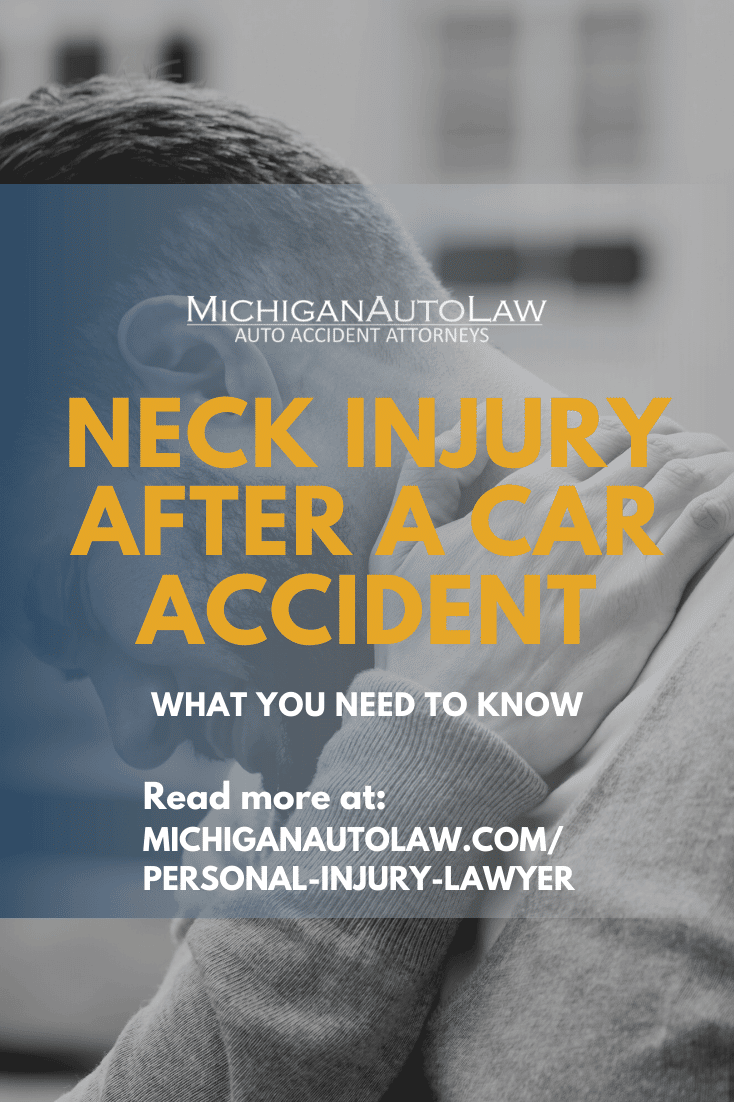Neck Injury After A Car Accident: What You Need To Know

A neck injury after a car accident is a serious and potentially life-altering injury. Frequently suffered, these injuries can disable victims and prevent them resuming their normal lives. Victims may be unable to work and they may be forced to endure chronic pain.
Victims must be able to identify the symptoms of a neck injury after a car accident and seek medical attention as soon as possible. Prompt detection, diagnosis and treatment is essential to a successful recovery and avoiding a lifetime of pain and disability.
Additionally, in order to make the fastest possible recovery and protect their legal rights, it is important that people know what to do if they have pain in this area of the body after a collision, what types of specific injuries they may be suffering, and what kinds of testing and treatment they can expect.
What to do for a neck injury after a car accident
If you suffered a neck injury after a car accident, follow these steps:
- Get examined immediately: Time may be of the essence. When it comes to properly diagnosing the cause of a neck injury after a car accident, the sooner a person gets the proper diagnostic tests and medical treatment for these symptoms, the sooner they can rule out a potentially life-threatening issues. As a lawyer, I always advise people that the sooner they can get the necessary and appropriate medical care, the sooner they can get back on the road to good health and a full recovery, but with this type of injury the key is to rule out a much more serious injury as soon as possible.
- Get medical treatment and get a referral for the appropriate diagnostic imaging to detect and diagnose if you have suffered this injury. A doctor can’t treat you until he or she knows what is causing these symptoms, and the appropriate diagnostic testing – often a CT scan – will enable your doctor to prescribe the best course of treatment for you and make the appropriate referrals for you.
- Early documentation always makes it easier to avoid future problems with your own insurance company. Early medical documentation, such as in an emergency room or as soon as possible with your family doctor, will prove to a health insurance company or a No-Fault insurance company that the neck injury after a car accident was the cause. If it does turn out to be a more serious injury, you’ve documented the early symptoms and again will be able to avoid many of the problems that arise when an insurance company is denying a causal relationship and refusing to pay for medical treatment. Early treatment and medical documentation create the temporal relationship that insurance companies will be looking for when they are being asked to pay for necessary medical care.
- Showing a clear temporal relationship between a collision and the documentation of treatment for a condition or injury also makes it easier to get a full and fair legal settlement for your injury when it is caused by another driver’s carelessness or negligence behind the wheel. Delays in seeking treatment hurt your ability to get better faster and make a good recovery, but it also often makes it harder for your attorney to get a reluctant insurance company to pay for your treatment and makes it harder to get a fair legal settlement after your crash.
- Don’t try to “tough it out”: this type of injury may be a symptom of a far more serious injury that may even become fatal if you don’t seek treatment right away. As a lawyer, I’ve seen so many instances where people felt like they didn’t want to “complain,” but within days or weeks what they thought would be a minor injury or something that would go away becomes far more serious.
- Talk to an attorney who is experienced at helping people injured in crashes. Most experienced lawyers have helped people suffering from a neck injury after a car accident. The initial call is always free so at the very least you will be informed as to what your insurance company is responsible to pay and what medical help and wage loss you are entitled to. An attorney can also help you review your medical records as well as the treatment and care you’re receiving to make sure bills are getting paid and with their car accident settlement calculator they can help you assess what your case might be worth if your pain and disability was caused by another driver’s negligence or carelessness.
- Tell your auto insurance company about your neck injury after a car accident. If you live in Michigan, make sure to include this in your application for No-Fault benefits, which is also referred to as your “written notice of injury” – which must be given to your No-Fault auto insurance company “within 1 year after the accident.” (MCL 500.3145(1) and (4))
- Do not sign any settlements, releases, or waivers related to your collision: Until you have talked with an experienced attorney who is looking out for your interests, do not sign any settlements, releases, or waivers that are presented to you by your auto insurance company, the at-fault driver’s auto insurer or any other insurance companies or persons.
Can I sue for a neck injury after a car accident?
Yes. If your auto insurance company refuses to pay for – or cuts-off – No-Fault benefits related to your injury, then you can sue for unpaid, overdue medical bills, attendant care, medical mileage, replacement services and lost wages because your injuries have prevented you from returning to work.
You can also sue the at-fault driver for pain and suffering compensation as a result of your crash-related pain or injury, but you will first have to show that the other driver was at-fault for causing the collision and that your back pain constitutes a “serious impairment of body function” under our auto law.
Additionally, you may be able to sue the at-fault driver for other economic damages, such as excess and future medical bills and lost wages.
Can a car accident cause a neck injury?
Yes, especially rear-end collisions – are a major cause of whiplash and a neck injury after a car accident. The force of the accident causes a driver’s or passenger’s head to be thrown forward and backward. This rapid back-and-forth whip-like movement frequently results in serious injuries, including damage to the bones of the spine, cervical disc and tears, sprains and strains of the ligaments, muscles, nerves and other tissues of this area of the body.
What are the most common symptoms of a neck injury after a car accident?
Below is a list of symptoms that a person may experience after being involved in a motor vehicle collision. But please keep in the mind the list is not exhaustive as all injuries to this area of the body are different:
- Pain and stiffness
- Restricted movement
- Loss of range of motion
- Worsening of pain with movement
- Tingling or numbness in the arms
- Tenderness or pain in shoulders and upper back
- Headache
- Trouble with balance/equilibrium
- Dizziness
- Ringing in the ears (tinnitus)
- Inability to concentrate
- Memory loss
- Blurred vision
- Tiredness and fatigue
- Feelings of nervousness
- Irritability
- Depression
- Nausea
- Inability to sleep
- Excessive sweating
Examples of neck injuries after a car accident
Victims may suffer many different types of neck injuries after a car accident. Here are the neck injuries that the lawyers at Michigan Auto Law see most frequently in their clients:
- Herniated cervical discs
- Protruding cervical discs
- Ruptured cervical discs
- Bulging cervical discs
- Spinal cord injuries
- Whiplash or soft tissue injuries
- Sprains
- Strains
- Stenosis of the cervical spine
- Facet joint injuries
Testing to detect and diagnose
The key to receiving the necessary medical treatment for pain and a neck injury after a car accident is properly detecting and diagnosing the injury.
This is where diagnostic tests and imaging come in. Properly used by doctors and medical staff in the Emergency Room and during physical examinations, the following diagnostic tests play a vital role in helping car accident victims on their road to recovery:
- X-rays
- CT Scans (computed tomography)
- MRI (magnetic resonance imaging)
- EMG (electromyography)
- SPECT (single-photon emission computed tomography)
- Myelography
- Nerve conduction velocity studies
- Discography or discogram
Treatment
Once a victim’s injury has been properly detected and diagnosed, the next step is for the victim to start treatment.
Importantly, determining the right course of treatment is not always a “one-size-fits-all” proposition. The victim’s doctor will make his or her recommendations based on the victim’s specific injury as well as the circumstances of the collision that caused the victim’s injuries.
Common treatments include:
- Physical therapy
- Massage therapy
- Rehabilitation therapy
- Spinal manipulative therapy
- Chiropractic treatments
- Short-term bracing for the neck
- Steroid injections to relieve pain
- Surgery
- Pain medication
- Strengthening exercises
Neck surgery
Surgery is the most drastic and invasive treatment option for a neck injury after a car accident.
But it may be the victim’s best – and only – treatment option to maximize his or her chances for a successful recovery. It all depends on what a victim’s doctor concludes is necessary given the nature of the victim’s injury.
Neck surgery options may include:
- Fusion – Fusing or joining two vertebrae to stop painful movement
- Discectomy – Removing the herniated or damaged portion of a disc
- Laminectomy/Decompression – Removing the vertebral bone known as the lamina that covers the spinal canal in order to relieve nerve pressure
- Vertebroplasty – Injecting bone cement into compressed or fractured vertebrae
- Implant artificial discs between injured discs – This provides stability and eliminates pain
Recovery from neck injuries
A victim’s recovery from a neck injury after a car accident depends on his or her specific circumstances, his or her specific injuries and on the specific course of treatment that was designed for the victim by his or her treating physician.
Keeping in mind how unique these types injuries are for each victim, consider the following observations about prognosis and recovery:
- Although fusion surgery is typically effective at treating broken vertebrae and stabilizing the spine, it is not always effective at eliminating pain and may contribute to arthritis in other vertebrae.
- Discectomy surgery is generally found to reduce herniated disc symptoms in 80-90% of victims who have suffered these types of injuries.
- Laminectomy surgery is generally found to reduce herniated disc symptoms in 60-90% of victims who have suffered these types injuries.
- Car accident victims who have suffered neck sprains or strains can usually expect recovery in nearly 70-100% of cases.
Need help? Call the attorneys at Michigan Auto Law
If you have suffered any pain or a neck injury after a car accident and you have questions about your legal rights and the significant legal compensation that you may be entitled to, call us toll free at (800) 968-1001 for a free consultation with one of our experienced attorneys.






